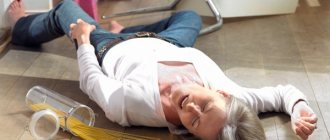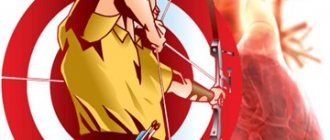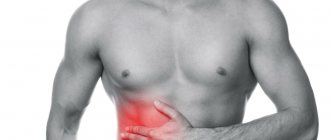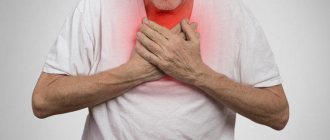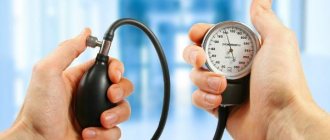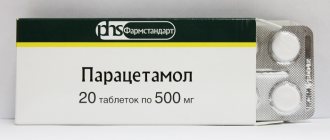Symptoms
Previously it was believed that normally there could be a slight difference in systolic blood pressure in one person when measured on different arms. But recent data suggest that a difference of 10-15 mm may indicate the presence, if not of cerebrovascular diseases, then at least of peripheral vascular pathology contributing to the development of arterial hypertension and other cardiovascular diseases. Moreover, although this sign has a fairly low sensitivity (15%), it is distinguished by a very high specificity of 96%. Therefore, blood pressure really, as has always been reflected in the instructions, should be measured on both hands, differences should be recorded to order additional examinations, and pressure should be classified according to the maximum value of both hands. To avoid mistakes, it is recommended in each case to measure the pressure on each arm three times at short intervals and consider the lowest numbers to be true. True, there are patients whose pressure values do not decrease with each measurement, but increase. * Optimal blood pressure is SBP (systolic blood pressure) < 120 / DBP (diastolic blood pressure) < 80 mm. * Normal blood pressure is 120-129/80-84 mm (prehypertension according to JNC-VII). * High normal blood pressure 130-139/85-89 mm Hg (prehypertension according to JNC-VII). * 1st degree of hypertension - sBP 140-159/dBP 90-99. * 2nd degree hypertension - sBP 160-179/dBP 100-109. * Stage 3 hypertension - SBP 180 and above/DBP 110 and above. * Isolated systolic hypertension - SBP greater than or equal to 140/dBP below 90.
Degree of manifestation
The normal blood pressure is 120 mmHg at the upper pressure, 80 mmHg at the lower pressure. An acceptable deviation is possible up to 140 to 90 mmHg. All indicators above the norm lead to the formation of pathologies of the body of varying levels of severity. Accordingly, there are three degrees of hypertension:
- Hypertension first st MBK 10: l10 - fluctuating values from 140 to 90 mmHg. Characterized by the appearance of mild level pathologies;
- Hypertension second st ICD 10: l10 - increase in blood pressure from 150 to 100 mmHg.
During treatment for hypertension of the 2nd stage, it will be possible to avoid a relapse, the transition of the disease to the third - severe degree. The second stage is perfectly amenable to treatment with gentle methods.
- Hypertension third degree ICD 10 - hypertension indicators exceed 180 per 110 mmHg. Has severe forms of pathology: stroke, heart attack, disability.
Causes
It is believed that one of the important etiological factors is neuropsychic stress that occurs after intense or prolonged emotional overload. Primary functional disorders occur in the cerebral cortex and in the centers of the hypothalamic region of the limbic-reticular complex. The excitability of the hypothalamic autonomic centers, mainly the sympathetic nervous system, increases, which leads to the development of pressor reactions. The minute output and vascular tone increase. The renal volume decreases, the excretion of sodium and water decreases, which accumulate in the vascular wall, contributing to its swelling. At the same time, the content of ionized calcium in the vascular wall increases. Renal ischemia leads to increased production of renin by the cells of the juxtaglomerular apparatus of the kidney. Renin converts angiotensinogen, which is produced in the liver, into angiotensin I. The latter, under the influence of convertase - angiotensin-converting enzyme (ACE), is converted into angiotensin II, which, in turn, stimulates the sympathetic nervous system, increases norepinephrine in granules and potentiates the vasoconstrictor effect . ACE also inactivates bradykinin, one of the stimulators of endothelial secretion of nitroxide (NO), the main endothelial relaxation factor. Thus, ACE is one of the key regulators of the balance between the factors of vasoconstriction and vasodilation, which determines the role of the ACE gene polymorphism (localized on chromosome 17q23) in the development of arterial hypertension.
Secondary
This is a type of pathology characterized by high blood pressure. Secondary hypertension is caused by disturbances in the functioning of those organs that affect the tonometer readings. According to ICD-10, this disease is designated by code I15.
Secondary hypertension is of the following types:
- renovascular. Its code according to the international classifier is I15.0;
- caused by kidney damage. Encrypted in ICD-10 as I15.1;
- secondary to endocrine disorders. Coded I15.2;
- unspecified - I15.9.
- the other is I15.8.
Secondary hypertensive disease occurs in 5% of cases, its features are the following:
- progresses quite quickly;
- the use of two or more medications does not produce a positive effect;
- affects mainly young people;
- develops in those people whose relatives and friends did not suffer from high blood pressure;
- despite taking antihypertensive drugs, the person’s condition continues to deteriorate;
- complete recovery is possible only by eliminating the problems in the functioning of the organ that provoked the jump in blood pressure.
Secondary hypertension can be caused by the following pathologies:
- endocrine system (diabetes mellitus, hypothyroidism);
- neurological (brain inflammation, head injury);
- renal (cancer, polycystic disease, nephrolithiasis, organ transplantation);
- adrenal glands (Itsenko-Cushing syndrome, Cohn syndrome, pheochromocytoma);
- cardiovascular (aortic inflammation, ischemia, vegetative-vascular dystonia).
Diseases manifested by hypertensive crisis and their codes according to ICD 10
Diseases that can manifest themselves or are diagnosed after fixing a hypertensive vascular crisis are various types of chronic high cardiac pressure (hypertension) with different types of complications and have the following codes and classifications in ICD 10:
- I10 includes essential, or primary, hypertension - a recorded increase in pressure.
- I11 includes hypertension with cardiac complications.
- I12 includes hypertension with kidney complications.
- I13 includes complications of the kidneys and heart, as well as their more or less severe combinations - up to heart and kidney failure.
- I14 is missing.
- Codes I15 contain secondary hypertension, that is, those cases when an increase in pressure up to a crisis is caused by other diseases:
- endocrine: for example, pheochromocytoma or other hormonal neoplasms, as well as diabetes;
- renal: renovascular (renal-vascular) disorders, and others - disturbances in the outflow of fluid and swelling are directly related to vascular tone.
- unspecified reasons: an increase in blood pressure up to a crisis state can be caused by stressful situations and excessive physical exertion, taking certain medications, a reaction to the weather, fluid retention in the body, including due to the consumption of salty foods or lack of drinking.
Arterial hypertension (according to ICD-10): stages, degrees, treatment
Hypertension is a pathology in which persistent high blood pressure is observed over a long period of time. Arterial hypertension (hypertension) in ICD 10 is listed under codes I10-I15/I00-I99.
The abbreviations encode the types of pathologies that occur when blood flow is disrupted. In ICD 10, a unique code designates types of diseases accompanied by hypertensive crisis and other disorders in adults with critical blood pressure (BP).
The concept of hypertension and the causes of its development
The term “hypertension according to ICD 10” describes a number of pathological conditions that develop against the background of critical blood pressure parameters. The disease is classified according to the causes that cause it.
Doctors have identified many types of pathology. As a result, arterial hypertension is not assigned a single coding code in ICD 10 (varieties of the disease are listed under codes I10-I15). All types are listed in one section - “Diseases caused by high blood pressure”.
Short-term surges in blood pressure are observed against the background of excessive physical or emotional and psychological stress. After removing the load, the values quickly return to normal. Sustained overestimated indicators indicate malfunctions in the body.
Negative factors excessively tone the arterial walls. The lumen of the vessels narrows, blood circulation becomes more difficult, and the pressure increases. Such changes end with the gradual progression of hypertension of degrees 1, 2 and 3 (all subtypes of pathology are encoded in ICD 10 under codes I10-I15).
Activation of the sympathoadrenal system is the main factor in the occurrence of hypertension. The human brain contains a vasomotor center that transmits signals along the nerve trunks that control the constriction and dilation of blood vessels.
In response to constant irritation, the brain sends commands that increase the tone of the vascular walls. Such a reaction forces the arteries to narrow and provokes an increase in blood pressure. Dysfunction of the circulatory system causes the development of hypertensive crisis, uncomplicated hypertensive conditions, severe manifestations (each subtype is listed in ICD 10 under a specific code).
Classification of hypertension
WHO experts divided the disease by type, taking into account:
- stages;
- degrees;
- types and subtypes;
- risks that aggravate the condition.
When making a diagnosis, doctors take into account all typologies of the disease. Guided by the ICD 10 codes, doctors monitor the dynamics of the pathology, record blurred and acute manifestations (hypertensive crises, ischemia, heart attack, stroke), and adjust the treatment regimen.
Stages of arterial hypertension
Arterial hypertension of the subtypes identified according to ICD 10 overcomes 3 stages of development - from asymptomatic to acute symptoms.
Degrees of hypertension
WHO experts have defined 3 degrees of hypertension.
Arterial hypertension code according to ICD 10
Hypertension in adults with different types of complications in the systematization according to ICD 10 is assigned unique codes.
Causes
With hypertension, 2 parameters increase at once - upper and lower pressure. The rise in parameters to peak values is due to negative factors of two types.
The condition, classified according to ICD 10 as hypertension, is caused by external factors:
- neuropsychic stress;
- insufficient physical activity;
- poor nutrition (addiction to salty, smoked, fried, sweet, fatty, alcohol);
- bad habits (smoking, drugs).
Hypertension also occurs against the background of internal problems:
- genetic predisposition;
- obesity;
- atherosclerosis;
- viscous blood;
- kidney diseases;
- impaired metabolism;
- endocrine diseases;
- excessive release of adrenaline during stress;
- high calcium concentration.
Primary form
Essential hypertension is found in 90% of patients with high blood pressure. There are 3 subtypes of primary hypertension
- hyperadrenergic (pressure rises due to high concentrations of adrenaline);
- hyporenin (the disease develops in old age with a large amount of the hormone aldosterone);
- hyporenin (the provocateur of pathology is renin).
If primary hypertension (code I10 according to ICD 10) is left to its own devices, a hypertensive crisis and other serious complications will occur.
Secondary form
Secondary hypertension is caused by concomitant pathologies. Based on the causes of occurrence, the disease is divided into 5 subtypes:
- endocrine;
- renal;
- neurogenic;
- hemodynamic;
- drug hypertension.
The disease is classified according to the nature of its development, blood pressure stability, and modifications of the fundus. There are 4 forms of hypertension (code I15 in the ICD):
- transient - blood pressure increases once, without causing complications;
- labile - if the disease is not treated, blood pressure values do not fall, the functioning of organs is disrupted;
- stable – blood pressure is high, the heart muscles are thickened, the blood vessels are damaged;
- malignant - the pathology is rapidly progressing, drug therapy is ineffective, serious complications arise (angiopathy, heart attack, stroke).
Degree of manifestation
Doctors classify hypertension (ICD code I10-I15) according to the risk of progression. Such systematization allows you to notice deterioration in health in time and make adjustments to the treatment regimen. Thanks to this tactic, it is possible to reduce the symptoms of the pathology, slow down its progression, and improve the quality of life.
Several degrees of risk of health deterioration have been identified. There are four of them:
- Low. The occurrence of dangerous cardiovascular diseases is observed in 15% of people. If patients undergo preventive examinations, change their lifestyle, and take medications as recommended by a doctor, their condition quickly stabilizes. They stop suffering from headaches, dizziness and other signs of hypertension.
- Average. The circulatory system is affected in 20% of patients. The doctor prescribes treatment based on the results of the studies.
- High. The probability of complications and concomitant pathologies exceeds 25%. Patients are given a therapeutic treatment regimen based on laboratory test data.
- Very high. The likelihood of developing complications increases in patients with associative disorders in the functioning of the body: heart attack, angina pectoris, diabetes. The heart muscle and blood vessels are affected in 30% of patients.
Consequence of the disease
High blood pressure destroys internal organs and causes damage to the brain and spinal cord. If you do not attach importance to this, irreversible destructive transformations develop in the body. Vessels located in the brain and other target organs narrow, become overgrown with atherosclerotic plaques, and rupture, unable to withstand the load.
Advanced hypertension is manifested by complications in the form of:
- hypertrophy of the cardiac ventricles;
- destruction of blood vessels in the eyes, retinal detachment, loss of vision;
- renal pathologies;
- dysfunctions of the genitourinary apparatus;
- diabetes mellitus;
- pancreatic diseases;
- brain diseases.
Every patient has the opportunity to reduce the risk of complications. You just need to visit a doctor and follow all the instructions.
Diagnostics
When diagnosing arterial hypertension using ICD 10 codes, the doctor differentiates the subtypes of the disease and identifies the underlying pathology. To make a correct diagnosis, the patient is prescribed a blood test, ECG, MRI, radiography, ultrasound of the heart and kidneys, as well as other organs involved in the destructive process.
Diagnosis is carried out as follows:
- Blood and urine tests. To confirm the diagnosis of “hypertension with destruction of renal tissue,” just such tests can be detected. Ultrasound and radioisotope scanning of the paired organ, vascular angiography, and urography of renal tissue are also performed.
- Hormone test and ultrasound of the thyroid gland. This test helps detect hypertension with endocrine disorders.
- Aortography. Narrowings in the aorta are visible on a chest x-ray. This diagnostic method allows you to clarify the diagnosis.
- ECG, ultrasound, phonocardiography, Doppler testing. The study of the heart muscle using similar methods is performed regardless of the age of the patients.
- In all patients, the fundus of the eye and cerebral vessels are examined.
Treatment
Doctors practice 2 treatment methods:
- drug therapy;
- non-drug methods of lowering blood pressure.
The likelihood of dangerous complications (heart attack or stroke) is influenced by the degree of increase in pressure, bad habits, physical inactivity, and obesity. In case of primary hypertension, it is important to make lifestyle adjustments, namely:
- stop smoking, alcohol;
- balance nutrition;
- establish sleep and wakefulness patterns;
- give the body adequate physical activity.
You need to understand that a new lifestyle significantly improves the prognosis for hypertension and other heart diseases without the use of medications. The primary form of pathology usually proceeds slowly. If you do not give up bad habits, it will become more severe.
Physical activity reduces the concentration of adrenaline and norepinephrine - substances that can constrict blood vessels, increase heart rate, and increase blood pressure. Optimal physical activity trains the cardiovascular system and respiratory organs. Exercise reduces weight, improves blood flow, and restores the transport of oxygen and nutrients to target organs and the heart.
Non-pharmacological treatment is recommended for patients with a low likelihood of progression of hypertension. The lack of positive dynamics with non-drug therapy leads the doctor to believe that the patient needs treatment with appropriate medications.
Treatment of hypertension during pregnancy, childbirth and the postpartum period requires different approaches. Therapy is aimed at reducing the likelihood of complications in the mother and child and the occurrence of premature birth.
Medication
The treatment regimen for arterial hypertension depends on the ICD 10 code, the severity of the disease, and the patient’s condition. The doctor prescribes:
- to suppress low and moderate hypertension, 1 drug that lowers blood pressure;
- for high and very high degrees of hypertension, 2 medications in a minimum dose.
In difficult cases, adhere to the following algorithm:
- if blood pressure does not drop to 140/90-120/80 with moderate hypertension, increase the dose of the drug used or prescribe another medicine in small doses (if the combination is unsuccessful, select 2 medications from different categories and prescribe the minimum doses);
- when blood pressure does not stabilize at high levels, increase the dose of medications used or introduce a drug from another category into the treatment regimen 3;
- if the pressure has dropped to 140/90-120/80, and the condition has worsened, an urgent suspension of taking the prescribed medications in the recommended dosage is necessary (until the body adapts to the new pressure levels, the drugs are taken in small doses).
Only a doctor selects and combines medications and determines doses. Uncontrolled use of drugs (as well as lack of treatment) leads to dangerous complications.
There are several categories of medications for the treatment of hypertension:
- angiotensin-converting enzyme inhibitors;
- angiotensin-1 receptor blockers;
- β-blockers;
- calcium antagonists;
- diuretics;
- renin inhibitors.
Traditional methods
High blood pressure can be successfully relieved using simple folk methods. The following remedies provide a good therapeutic effect:
- Flax-seed. Stabilizes blood pressure, normalizes lipid metabolism, clears blood vessels of plaque. Eat 3 tablespoons of seeds daily, adding them to different dishes.
- Red pine cones. The alcohol tincture is consumed 3 times a day on an empty stomach. Single dose – 5 ml.
- Garlic. Add a gruel of 2 cloves to 250 ml of boiled water. Leave for 12 hours to infuse, then filter. Drink 100 ml of the extract in the morning and evening. Treat for 30 days.
Diet
People with hypertension must strictly follow a low-calorie diet (no more than 2500 kcal per day). They should divide their daily diet into 5-6 meals (eat in small portions - 200-250 g each). You should have dinner 2 hours before bedtime.
Patients are allowed to eat boiled, baked and steamed food with minimal added salt. It is necessary to monitor the balance of proteins, carbohydrates, fats, add them to the diet in a ratio of 1:4:1. It is advisable to eat foods high in potassium, magnesium, and vitamins B, P, and C.
Patients are allowed to use:
- black and bran bread, crackers;
- lean soups;
- soups with meat (3 times a week);
- low fat meat and fish;
- vegetable dishes;
- fermented milk products;
- fruit and berry casseroles;
- porridge, seafood;
- freshly prepared juices.
Prevention
To avoid the development of any type of hypertension according to ICD 10 (the international coding of diseases), you need to eat right from childhood. It is necessary to limit the consumption of fats, sweets, fast foods, and increase the proportion of vegetables and fruits in the diet.
With overeating and a passive lifestyle, complications often develop. Adequate physical activity and giving up bad habits help to avoid them. To restore health, you need to consult a doctor, control your weight, take an active part in sports (do fitness, swim, walk).
conclusions
If arterial hypertension is confirmed according to any ICD 10 code, you should work with your doctor to create an effective treatment regimen.
Elimination of pathology is directly related to life attitudes. Developing the right habits and following medical recommendations is the right path to recovery.
Source: https://serdechnie-bolezni.com/davlenie/arterialnaya-gipertenziya-kod-po-mkb-10
ICD 10 codes for various types of arterial hypertension
Hypertension code ICD 10, designated I11, including I11.0 and I11.9, denotes diseases with predominant damage to the heart. This subgroup does not include combinations of heart and kidney damage; they belong to codes I13 and have 4 internal codes - I13.0, I13.1, I13.2 and I13.9
Codes I12 are for hypertension with renal involvement. The international classification distinguishes hypertension with the development of renal failure against the background of high blood pressure (I12.0). Code I12.9 indicates hypertension with kidney damage without the development of insufficiency of their functions.
The alphanumeric designations I15.0, I15.1, I15.2, I15.8, I15.9 hide various variations of secondary hypertensive disease. For primary hypertension, code I10 is assigned. Hypertensive crises are usually noted this way.
A hypertensive crisis according to ICD 10 code refers to essential hypertension, although a sharp rise in pressure, life-threatening, can also occur with secondary manifestations of the disease. Code I10 is sometimes changed to other codes for hypertensive diseases after the diagnosis has been clarified. Quite often this occurs with hypertension, which affects both the heart and kidneys.
In Russia there is still no legally established classification of hypertensive crises . In the USA and a number of other countries, crises in hypertensive patients are divided into two types:
The first of them requires urgent hospitalization, regardless of the ICD 10 code. The second can be treated at home, followed by treatment in a hospital. And this data can also be subjected to statistical processing.
Treatment of hypertension
The main danger of the disease lies in complications, including damage to the heart and kidneys, circulatory system, and brain. Irreversible changes in the arteries and those developing against the background of the disease can lead to death. Therefore, treatment should be comprehensive, aimed not only at reducing blood pressure, but also at maintaining immunity and strengthening target organs. Treatment of the primary form of hypertension can occur using the monotherapy method: one drug is prescribed. Thiazide and thiazide-like diuretics are most often prescribed. Patients with the second and third degrees of the disease are prescribed combination therapy. Its essence is the normalization of blood pressure using drugs with different mechanisms of action.
During therapy, heart tests and regular blood and urine tests are performed. Based on the data obtained, the doctor selects a set of medications.
Patients who have been identified as having the first degree and risk 1 can also be treated with non-drug methods. To recover, it is enough to change your lifestyle, stick to a diet, stop smoking and drinking large quantities of alcohol.
Manifestations of hypertensive crisis
A hypertensive attack is characterized by pronounced symptoms, which manifest themselves depending on the form and intensity of the disease.
Your blood pressure will always be 120/80 if you drink in the morning.
Main manifestations of GC:
- severe pain in the head (acute, pressing);
- nosebleeds;
- tachycardic manifestations;
- severe dizziness, often with loss of consciousness.
- convulsive states, tremor;
- lethargy, drowsiness, chills;
- states of increased excitability, emotional instability;
- insomnia, taking a long time to fall asleep, intermittent sleep;
- anxiety states;
- painful sensations in the eyeballs, visual disorders (dots before the eyes);
- acoustic disorders (tinnitus);
- nausea and vomiting.
Crisis prevention
To prevent a hypertensive attack from returning and to normalize the general condition, preventive measures are necessary:
- Blood pressure control (you need to measure your blood pressure several times a day, tracking your readings).
- Taking blood pressure-lowering medications prescribed by your doctor.
- Monthly medical examinations.
- Stabilization of the psycho-emotional background, prevention of stressful situations.
- Adequate physical activity.
- Quitting bad habits (smoking, alcohol, overeating).
- Mandatory weight control.
- Compliance with the rules of prescribed diet therapy.
- Control of daily water consumption.
Particular relevance of the problem
Arterial hypertension is the most common chronic disease, affecting approximately 20-30% of people.
Increased attention to this problem is explained by the fact that hypertension is the main factor provoking the development of hypertensive attacks. . The relevance of the problem of hypertensive crisis lies in the increase in the number of attacks in people
Over the last 3 years alone, the number of ambulance calls for HA has increased 1.5 times.
The relevance of the problem of hypertensive crisis lies in the increase in the number of attacks in people. Over the last 3 years alone, the number of ambulance calls for HA has increased 1.5 times.
It is worth noting that since there are quite a large number of reasons for the development of HA, no one is immune from the occurrence of this condition.
GK after alcohol
Alcohol has a negative effect on the vascular system, causing an increase in blood pressure.
Alcohol is characterized by a unique effect on the circulatory system.
During the first time after drinking alcohol, blood vessels dilate under its influence, which leads to a decrease in systemic blood pressure.
Then comes the secondary effect of alcohol , in which the blood vessels narrow to a greater extent than before drinking alcohol.
As a result of this, blood pressure increases, so the development of a hypertensive crisis after alcohol is a completely natural phenomenon, especially in hypertensive patients.
It is worth noting that this happens either with a single consumption of a large amount of alcohol, or with regular excessive consumption.
HA in children
Hypertensive crisis in children develops against the background of secondary symptomatic hypertension.
HA occurs more often in adolescent children
Common causes of this condition are the following ailments:
- kidney disease (glomerulonephritis, renovascular disease);
- neurogenic abnormalities (disorders due to poisoning, meningitis, traumatic brain injury);
- pheochromocytoma (adrenal tumor);
- hyperthyroidism;
- Coarctation of the aorta (a type of congenital defect of the vessel).
Important! In adolescence, attacks can also develop with primary hypertension. . In adolescents, this condition develops as a type of vegetative-vascular dystonia, which is associated with neuroregulatory, autonomic, and endocrine disorders
In adolescents, this condition develops as a type of vegetative-vascular dystonia, which is associated with neuroregulatory, autonomic, and endocrine disorders.
Symptoms of the condition in children are the same as in adults and also require emergency measures.
GC in the elderly
Hypertensive crisis in older people is diagnosed much more often. Only 18% of victims are people under 60 years of age.
Features of hypertensive attacks in old age are:
- High levels of upper pressure.
- Damage to baroreceptors and carotid arteries.
- High pressure lability.
- Tendency to a protracted relapsing course.
- Gradual development of the process.
- Frequent development of consequences in the form of cardiovascular diseases.
In addition, elderly people are characterized by a blurred clinical picture of the condition, which greatly complicates its diagnosis and treatment.
Causes
Arterial hypertension does not appear overnight; it is preceded by the second stage of the disease. As a rule, the progression of pathological changes occurs due to improper treatment or its complete absence in the second degree of the disease.
Experienced heart attacks, congenital heart and vascular defects, endocrine pathologies, heart failure and other chronic diseases of internal organs can accelerate the course of the disease. Hypertension quickly moves to a new stage in people who have suffered head injuries and emotional turmoil.
How does a hypertensive crisis proceed?
The main way to establish a crisis is the readings of a tonometer, since its symptoms may coincide with the symptoms of migraines and other types of headaches, with manifestations of dystonia, cerebrovascular accidents of other origins, heart diseases (without increased blood pressure), etc.
Symptoms of hypertensive crisis
During an attack of arterial hypertension, the following symptoms will be observed:
- absolute symptom: tonometer readings above 140/90. In this case, it is necessary to take into account the peculiarities: in a young girl who has a normal blood pressure of about 100/60, the indicator of an attack may be a pressure of 140/90, and in an elderly man with hypertension, who regularly has a pressure of 160/90, a symptom of critical hypertension will be an increase in pressure relative to its “norms”;
- the most common symptoms (may be absent or correspond to another disease): a noticeable increase in pulse, headache, chest pain and shortness of breath, weakness, chills and a feeling of coldness in the extremities, sweating, dizziness, nausea, spots and flashes before the eyes, convulsions, lightheadedness .
It is also important to remember that, although attacks of critical hypertension usually accompany hypertension in the elderly, they can also occur in childhood, adolescence, and in adults who do not have obvious health conditions for vascular diseases. . Hypertensive cerebral crisis
Hypertensive cerebral crisis
Chronic high blood pressure can lead to hypertensive encephalopathy, especially when combined with various disorders of cerebral blood flow, for example, against the background of so-called osteochondrosis, that is, problems with compression of blood vessels in the neck. As a result, an attack of high blood pressure can manifest itself neurologically and lead to a cerebral crisis, otherwise, a transient cerebrovascular accident (TCI), which, in addition to the symptoms listed above, may resemble a stroke. PNMK can also lead to strokes in the near future after an attack, since it implies temporary brain hypoxia. Cerebral crisis should not be confused with a vertebrobasilar attack (dizziness when changing body position).
The main symptoms of cerebral crisis, in addition to the general hypertensive symptoms mentioned above, may be:
- loss of balance;
- disturbances of consciousness: problems with memory, naming objects, speech, lethargy;
- visual impairment: double vision, temporary blindness;
- muscle stiffness of half the body or face: this symptom, as is known, can also indicate a stroke, but can also accompany migraines, so it requires an emergency call, but does not yet mean a stroke.
GB degrees
First degree hypertension
The first degree of hypertension is characterized by pressure ranging from 140 to 159 and from 90 to 99 mmHg.
The initial stage of the disease is not characterized by permanent disturbances in the functioning of the heart muscle, and exacerbations do not have serious consequences. The first degree of arterial hypertension can occur unnoticed by the patient and not be detected during standard doctor’s appointments. Crises alternate with the complete disappearance of hypertensive symptoms. To diagnose and diagnose, blood pressure is measured three times a day and urine and blood tests are taken. Regular checks are recommended even for people at risk level 1.
Early detection of the disease will avoid many serious consequences.
Arterial hypertension of the 1st degree is accompanied by the following symptoms:
- Headache that gets worse during exercise
- Dizziness,
- Weak nagging pain in the left side of the chest,
- Ringing and noise in the ears,
- Sleep problems
- Flashing black dots before the eyes,
- Increased heart rate.
Symptoms can manifest themselves either individually or as a group. The initial stage of hypertension has complications:
- Microinfarctions of the brain,
- Nephrosclerosis of the kidneys,
- Left ventricular hypertrophy
- Ischemic stroke.
The risk of complications is low, and they appear only if symptoms are ignored and treatment is not started in a timely manner. If the patient does not take any action and does not adhere to the doctor’s recommendations, the initial degree of the disease can quickly develop into high-grade hypertension.
Initial treatment often does not require medications and consists of a comprehensive diet, a healthy and active lifestyle, and regular check-ups with a doctor.
Second degree hypertension
This degree of hypertension is characterized by the following pressure indicators:
- Upper: from 160 to 179 mmHg,
- Lower: from 100 to 109 mmHg.
The increase in blood pressure is prolonged and rarely returns to normal levels on its own. Arterial hypertension grade 2, risk 1, is accompanied by:
- Nausea,
- Constant and severe fatigue,
- Vascular insufficiency,
- Arterial narrowing,
- Hyperemia,
- Increased sweating
- Microalbuminuria,
- Swelling of the face,
- Passing and sudden deterioration of vision,
- Numbness of the limbs,
- Lipid metabolism disorders
- Hypertensive crises,
- The appearance of symptoms of target organ damage,
- Pathologies of the fundus.
A hypertensive crisis can be of a neurovegetative, edematous or convulsive nature.
The symptoms of this grade 2 hypertension are more severe for the patient. A person suffers from prolonged and frequent attacks of high blood pressure.
Stage 2 arterial hypertension (AH) also has a number of complications. These include:
- Atherosclerosis,
- Aortic aneurysm,
- Thrombosis of the brain,
- Angina pectoris.
- During the disease, target organs are affected: the brain, kidneys and heart, eyes, blood vessels.
A feature of arterial hypertension of the 2nd degree, risk 2, is severe angina pain. This form of hypertension occurs more often in women and leads to disruption of the cardiovascular system. The disease still preserves the person’s ability to work. The exception is professions that use physical force or are emotionally complex.
Treatment tactics for uncomplicated attacks
In the treatment of uncomplicated hypertensive crisis, medications in the form of tablets are used.
These include Clonidine, Nifedipine and Captopril. Clonidine is suitable for patients who have a history of stroke or rapid heart rate. Stories from our readers
Conquered hypertension at home. It's been a month since I forgot about pressure surges. Oh, I tried so many things - nothing helped. How many times did I go to the clinic, but they prescribed useless medications over and over again, and when I returned, the doctors simply shrugged their shoulders. I finally dealt with the pressure, all thanks to this article. Anyone who has problems with blood pressure should read it!
Read the full article >>>
If other antihypertensive drugs help increase cardiac output, then Clonidine is not characterized by this feature. The therapeutic effect is detected an hour after use.
In a situation where the first tablet did not give the required therapeutic effect within 60 minutes, the medication is repeated in a similar dosage.
Contraindications are the following situations:
- Difficult work that requires high concentration, as the drug gives a pronounced sedative effect.
- If the etiology of GC is due to severe mental disorders.
Nifedipine helps prevent stroke and relieves the alarming symptoms of an attack. It is available in the form of chewable tablets. The maximum time for which the medicine works is half an hour.
It should be noted that the medication can lead to a hypotensive attack due to a sharp decrease in blood pressure. Therefore, the dosage and frequency of use must be accurately calculated.
When stopping an uncomplicated hypertensive crisis, Captopril is often used - an effective and inexpensive remedy. The advantage is that there are few contraindications; it can be taken in old age.
An attack that threatens complications from target organs must be stopped quickly. First of all, call an ambulance. Delay can complicate the serious picture and lead to the death of the patient.
At this stage of hypertension, many standard hypertensive medications do not give the required effect
It is important to reduce blood pressure by 20-25% in the first hour of the crisis.
Sodium nitroprusside helps prevent negative consequences and lower blood pressure. The advantage is that it operates smoothly and its action can be controlled.
The medicine gives the following effects:
- Dilates blood vessels.
- Reduces heart rate.
If you have a history of hypothyroidism, impaired cyanide metabolism, or kidney pathology, you should not use the drug.
Use with extreme caution when intracranial pressure increases.
Sodium nitroprusside helps normalize coronary circulation and reduces the intensity of clinical manifestations. Incorrect dosage can complicate the clinical course, leading to intoxication, dizziness, nausea, and increased body temperature.
To relieve a hypertensive crisis, it is permissible to use Nitroglycerin in the form of tablets or injections; it acts quickly, but has a short-term effect. Trimetaphan camsilate is administered intramuscularly, there are many contraindications. Modern analogue of Corinfar.
Heart attacks and strokes are the cause of almost 70% of all deaths in the world. Seven out of ten people die due to blockages in the arteries of the heart or brain.
What’s especially scary is the fact that a lot of people don’t even suspect that they have hypertension. And they miss the opportunity to fix something, simply dooming themselves to death.
- Headache
- Increased heart rate
- Black dots before the eyes (floaters)
- Apathy, irritability, drowsiness
- Blurred vision
- Sweating
- Chronic fatigue
- Swelling of the face
- Numb and chilly fingers
- Pressure surges
Even one of these symptoms should give you pause. And if there are two of them, then have no doubt - you have hypertension.
How to treat hypertension when there are a large number of medications that cost a lot of money?
Most medications will do no good, and some may even be harmful! At the moment, the only medicine that is officially recommended by the Ministry of Health for the treatment of hypertension is NORMIO.
Before
The Institute of Cardiology, together with the Ministry of Health, is conducting a “
no hypertension
” program.
Within the framework of which the drug NORMIO is available FREE OF CHARGE
to all residents of the city and region!
Source: davleniya.net
Groups of diseases with increased blood pressure
I10 Primary hypertension:
- High blood pressure.
- Arterial hypertension (benign type and malignant type).
This type of hypertension is the most common. Occurs in nine out of ten patients. Despite this spread of the disease, its causes remain unclear. Presumably, it occurs as a result of hereditary and genetic disorders, as well as after constant, high emotional overload and obesity. The benign form, as a rule, proceeds slowly, and in the initial stages the pressure rarely rises. Sometimes it is possible to detect the presence of hypertension only during preventive examinations. The malignant form has an acute course, is difficult to treat and is dangerous with life-threatening complications.
Signs of primary hypertension:
- headaches, feeling of pressure on the head;
- the nose often bleeds;
- disturbed sleep, high excitability;
- tachycardia;
- ringing in the ears and flickering of sparks before the eyes;
- dizziness;
- increased blood pressure;
- in case of refusal or absence of regular treatment, target organs are affected (kidneys, heart, small vessels, brain), and severe complications develop (hemorrhages in the brain, retina, renal failure, heart attack).
I11 Hypertension causing predominantly cardiac damage:
- I11.0 With cardiac (congestive) failure (Hypertensive heart failure).
- I11.9 Without cardiac (congestive) failure (Hypertensive heart disease not otherwise specified (NOS)).
Typically occurs in people over 40 years of age. It occurs due to increased work of the heart due to spasm of arterioles. Increased work is necessary to push blood through the vessels. It is not always possible for the left half of the heart to completely expel blood from the cavity. So its expansion gradually increases, which is combined with inhibition of functions. In addition, spasm of small myocardial vessels prevents the heart cells from being fully enriched with oxygen, microelements and nutritional components, and micro-strokes occur. The pathological condition is accompanied by signs of primary arterial hypertension with predominantly cardiac symptoms: heart pain, shortness of breath, angina attacks, heart failure.
It has three degrees of development:
- The first is without damage to the heart.
- The second is that there is an enlargement of the left ventricle.
- The third is heart failure, heart attack.
I12 Hypertension causing predominantly kidney damage:
- I12.0 Combined with renal failure (renal hypertensive failure).
- I12.9 Without the development of renal failure (Renal type of hypertension NOS).
Against the background of high pressure numbers, changes occur in the structure of small renal arteries. Primary nephrosclerosis develops, which includes the following pathological changes:
- fibrosis of renal tissue;
- changes in small vessels (hardening and thickening of walls, loss of elasticity);
- the renal glomeruli cease to function, and the renal tubules atrophy.
There are no characteristic clinical symptoms of kidney damage in hypertension. Signs appear in the later stages, when a primary shriveled kidney or renal failure develops.
Specialized examinations help identify the involvement of the kidneys in the disease process:
- Ultrasound of the kidneys;
- urine test for protein (albuminuria more than 300 mg per day directly indicates kidney damage);
- blood test for uric acid, creatinine;
- study of glomerular filtration rate (indicative is a decrease of less than 60 milliliters/min/1.73 m2).
Patients with this pathology need to strictly limit salt in their food. If ineffective, medications are added (AP enzyme inhibitors, angiotensin II antagonists), which have the ability to protect renal tissue.
I13 Hypertension causing primary damage to the heart and kidneys:
- I13.0 Process with heart failure.
- I13.1 Process with renal failure.
- I13.2 Process with heart and kidney failure.
- I13.9 Unspecified.
This form of hypertension combines various signs of involvement of the heart and kidneys in the pathological process, up to functional or organic failure of one or both organs at once.
I15 Secondary (symptomatic) hypertension includes:
I15.0 Renovascular increase in pressure. I15.1 Secondary to other kidney diseases. I15.2 In relation to diseases of the endocrine system. I15.8 Other. I15.9 Unspecified.
Increased blood pressure of a symptomatic nature includes forms of hypertension caused by damage to various organs. Pathological processes of organs involved in maintaining blood pressure balance lead to its fluctuations. Hypertension of this type accounts for at least 5% of all increases in pressure.
Symptomatic hypertension is characterized by:
- Lack of effect during drug treatment with two or more drugs.
- The course of the disease worsens, despite the positive effects of medications.
- The disease progresses rapidly.
- It usually occurs in young people.
- There is no arterial hypertension in immediate family members.
About 70 diseases lead to increased blood pressure. These include:
- Renal diseases (glomerulonephritis, inflammation of the kidneys, polycystic lesions, pathologies of the connective tissue of the kidneys (lupus, arteritis), urolithiasis, hydronephrosis, tumor conditions, trauma, kidney transplantation).
- Diseases of the adrenal glands (Itsenko-Cushing's disease, Cohn's disease, pheochromacytoma).
- Cardiovascular pathologies (atherosclerotic damage to the aorta, inflammation of the aorta, aortic aneurysms).
- Neurological diseases (injuries and inflammations of the brain or meninges).
- Endocrine diseases (for example, diabetes mellitus, pathological increase or decrease in thyroid function).
Uncontrolled use of a number of medications (for example, hormonal contraceptives, MAO inhibitors together with ephedrine, anti-inflammatory drugs) can also cause a secondary persistent increase in blood pressure.
I60-I69 Hypertension involving cerebral vessels.
Included in the ICD-10 rubricator in the group of brain lesions. They do not have a specific code, since they can be present in any brain pathology from this section.
As a rule, in the absence of treatment or inadequate dosages of drugs, high blood pressure causes damage to the arteries and veins of the brain. Elevated blood pressure numbers are one of the most important indicators of the development of the stroke process (three times more often than with normal levels). With hypertension, sclerosis (microangiopathy) forms in the small arteries and veins of the brain. Because of this, either blockages of blood vessels occur, or they rupture with an outpouring of blood into the brain matter. Not only small vessels are affected, but also large vascular trunks. When they become blocked, a stroke develops. Long-term deterioration of blood circulation in the affected vessels leads to a lack of oxygenation of brain cells and a lack of nutritional components. This leads to damage to the functioning of the brain, and mental abnormalities develop (vascular dementia).
H35 Hypertension with damage to the blood vessels of the eye.
It is classified as a separate group in ICD-10 due to the fact that it can often lead to severe complications: hemorrhages in the retina, vitreous body, tractional retinal detachment. Hypertension leading to eye damage can be of any type (primary, secondary, etc.). Requires separate observation and treatment.
I27.0 Primary pulmonary hypertension.
The specific reasons for its development have not been established. Rarely found. As a rule, it begins to develop at the age of 30. It manifests itself as a long-lasting increase in blood pressure in the vascular basin of the pulmonary artery due to the narrowing of small vessels and an increase in resistance in them. We can talk about pulmonary hypertension when the pressure in the pulmonary artery increases above 25 mmHg. Art. in a calm state and above 30 mm Hg. Art. during load.
- Shortness of breath at rest, but especially pronounced during exertion. As a rule, there is no suffocation.
- Pain in the chest area of various types. They are not relieved by nitrate preparations.
- Fainting, dizziness, heart palpitations.
- Dry cough, especially during exercise.
- Cough with bloody sputum.
P29.2 Hypertension in the newborn.
Most often, neonatal hypertension is caused by blockage of the renal artery or its branches by a blood clot and congenital narrowing of the aorta (coarctation). Other causes may include: polycystic renal pathology, kidney hypoplasia, kidney inflammation, tumor processes, pheochromacytoma, Cushing's disease, maternal drug addiction, uncontrolled use of glucocorticosteroids, adrenomimetics and theophylline.
In a third of newborns, the disease may occur without clinical manifestations. Others experience heart failure, enlargement of the heart and liver, the skin becomes bluish, convulsions are possible, even coma and cerebral edema.
I20-I25 Hypertension with damage to the coronary vessels.
One of the target organs damaged during arterial hypertension is the coronary vessels. They carry blood to the myocardium. With high pressure, they thicken, lose elasticity, and their lumen becomes smaller. With such changes, there is a high risk of infarction (hemorrhagic with increased fragility of the vascular wall, ischemic with closure of the vascular lumen).
O10 Pre-existing hypertension complicating the course of pregnancy, childbirth and the postpartum period:
O10.0 - O10.9 includes all types of hypertension (primary, cardiovascular, renal, mixed and unspecified).
O11 Pre-existing hypertension with associated proteinuria.
It was present before conception and persists after childbirth for at least 1.5 months. Treatment is prescribed if necessary.
O13 Pregnancy-induced hypertension, in which there is no significant proteinuria:
- Pregnancy-induced hypertension NOS.
- Mild preeclampsia.
O14 Pregnancy-induced hypertension accompanied by severe proteinuria:
- O14.0 Moderate preeclampsia.
- O14.1 Severe preeclampsia.
- O14.9 Unspecified preeclampsia.
It is characterized by severe swelling and the release of protein in the urine (from 0.3 grams per liter or more). Develops after the fifth month. It is considered a pathological condition that requires observation and treatment by a doctor.
O15 Eclampsia (O15.0 occurred during pregnancy, O15.1 developed directly during childbirth, O15.2 developed in the early postpartum period, O15.9 process unspecified in terms of timing).
O16 Maternal exlampsia, unspecified.
A severe pathology in which blood pressure rises so high that it becomes life-threatening for the mother and child. The reasons for the development are not exactly clear. Perhaps they are genetic failures, thrombophilia, infectious lesions. The triggering factor for development is fetoplacental insufficiency.
Symptoms of developing eclampsia:
- Cramps. First, small facial muscles, then arms and other muscles of the body.
- Trouble breathing, wheezing.
- Confusion and loss of consciousness.
- Severe blueness of the skin and mucous membranes.
- Clinical cramps of almost all muscles.
- Eclamptic coma.
Types of classifications for hypertension
Arterial hypertension according to ICD 10 is divided into primary and secondary. In this case, primary hypertension (essential) is an independent disease, and secondary - as symptoms of the underlying disease, for example, renal failure.
Experts recommend the following classification for use:
- organs are not damaged;
- there are signs of disturbances in the functioning of target organs identified during the examination;
- organ damage is significant.
In addition, a classification is used according to the clinical course, persistence of increased blood pressure, and changes in the fundus:
- transient, that is, with a one-time increase in pressure, without damage, without treatment, blood pressure does not decrease;
- labile, examination reveals abnormalities, without treatment the blood pressure level does not decrease;
- stable, blood pressure level is very high, there are changes in the veins, hypertrophic changes in the heart;
- malignant, develops rapidly, is almost impossible to treat, complications such as stroke, heart attack, and angiopathy often occur.
Using ICD 10, you can accurately determine the stage and form of the disease, make predictions about therapy, and the development of complications. This is necessary to create an effective treatment regimen.
Source https://serdce-med.ru/arterialnaya-gipertenziya/mkb-10/
For people far from medicine, the phrase hypertension code according to ICD 10 does not mean anything. Even if the person himself suffers from this terrible disease. Many people understand that we are talking about high blood pressure, but what does the code with the strange abbreviation ICD have to do with it and why is it with the number 10 remains a mystery to them.
Everything is quite simple - each disease has its own code in a special disease classifier. There are several codes in this list for various manifestations of hypertension, and the incomprehensible ICD is a simple and understandable thing.
Video
Arterial hypertension is a broad group of pathological conditions characterized by increased blood pressure. Hypertension is presented in ICD-10 with an extensive list of conditions that cause it. Depending on the main causative agents leading to increased blood pressure, hypertension is classified into different types. In addition to the reasons, the classification is based on the severity of the disease, risk factors, concomitant diseases, and age.
The International Disease Rubricator allows you to accurately determine the presence of a pathological increase in blood pressure. To do this, consider changes in systolic (“upper”) and diastolic (“lower”) indicators. Modern ICD-10 operates with the following meanings:
- The optimal value is 120/80 mmHg.
- The normal value is up to 134/84 mmHg. Art.
- High normal value - up to 139/89 mmHg. Art.
The distribution of systolic and diastolic blood pressure helps to divide hypertension into characteristic degrees of severity:
| First | up to 159 | up to 99 |
| Second | from 160 to 179 | from 100 to 109 |
| Third | More than 180 | More than 110 |
According to ICD-10, hypertension is included in the large section “Diseases characterized by increased blood pressure” code I10–I15. Despite the vastness of this group, ICD-10 separately considers increased pressure during pregnancy, pulmonary type, neonatal pathology and disease involving the coronary vessels.
Treatment methods
After emergency care has been provided to the victim, the doctor prescribes appropriate treatment.
Therapy consists, among other things, in preparing the patient’s consciousness for a healthy life. The victim of a crisis must give up smoking and alcoholic beverages
After stopping the attack, it is very important to adjust your diet - foods should be not only healthy, but nutritious. Doctors recommend doing therapeutic exercises daily, and a relaxing massage is helpful.
Drug therapy
Drug treatment should only be prescribed by the attending physician. Basically, treatment procedures involve lowering blood pressure. The doctor prescribes short-acting calcium antagonists (Corinfar, Nifedipine). These medications have a relaxing effect on the vascular walls. They are prohibited for tachycardia, severe aortic stenosis, and circulatory decompensation.
There are many effective medications to relieve an attack, but if they do not have a positive effect, the doctor may prescribe the following medications:
- Beta adrenergic receptors. The use of these medications requires monitoring the patient's heartbeat and blood pressure. If it is impossible to use Obzidan, Proxodolol is prescribed. They are contraindicated if the patient suffers from heart pathologies, bradycardia, or poor atrioventricular conduction.
- If the patient experiences fear during a crisis, about 4 mm of Droperidol is prescribed, which has a neuroleptic and hypotensive effect.
- Administration of Furosemide may be necessary if the patient has circulatory problems or renal failure.
- Injections of Dibazol or Eufillin are recommended for crises with severe symptoms of brain damage.
If an attack is caused by withdrawal from a particular hypertensive drug, then the first step is to take it in small doses.
Treatment of hypertensive conditions is also carried out using folk remedies. To prevent repeated crises, it is necessary to follow the doctor’s recommendations, take medications in the prescribed dosage, and lead a healthy lifestyle.
Source https://gipertonia03.ru/neoslozhnennyj-gipertonicheskij-kriz.html
« Previous entry
Treatment
Many people ask, is it possible to cure hypertension? The answer to this question depends on the stage of development and the reasons that provoked it. Only the first stage of the disease can be completely cured. At other stages, the disease can only be corrected so that the person can lead a normal life.
Treatment of stage 3 hypertension involves the use of several medications. It is almost impossible to reduce blood pressure with just one drug. The treatment regimen is developed by selecting drugs from the following groups:
- beta-blockers - Metoprolol, Bisoprolol;
- diuretics - Hydrochlorothiazide, Furosemide;
- calcium antagonists - Nimodipine, Amlodipine;
- ACE inhibitors - Lisinopril, Losartan;
- alpha blockers - Doxazosin, Alfuzosin;
- renin inhibitors - Aliskiren.
The most effective regimens are those involving an ACE inhibitor and a diuretic or a calcium antagonist, a beta blocker and a diuretic.
Changing your regimen or stopping taking medications without consulting your doctor is strictly prohibited. In the case of the third stage of hypertension, medications are necessary not to lower the current pressure, but to prevent its further increase.
Diet food
You can fight hypertension not only by regularly taking medications, but also by eating right. Daily food should be divided into 5-6 servings. Hypertensive patients should not fast or practice fasting days. At the same time, you should exclude from your diet foods that cause blockage and narrowing of blood vessels. Products contraindicated for high blood pressure include:
sausages and smoked meats;- marinades and pickles;
- fatty meats and fish varieties;
- butter and cream;
- coffee;
- soda;
- tomatoes;
- cakes, muffins and sweets;
- dairy products with a high percentage of fat.
Try to completely eliminate salt and alcoholic beverages from the menu. They have a negative effect on blood vessels, reducing their elasticity, retaining water in the body and causing surges in blood pressure.
Hypertensive patients need to eat more fresh vegetables and fruits, whole grain cereals, legumes, herbs and seafood.
Folk recipes
Blood pressure is reduced if you drink half a glass of blackcurrant juice every day. Mint tea with honey and ginger stabilizes the functioning of the heart muscle and strengthens blood vessels.
Regular intake of garlic broth can reduce blood pressure by 10-15 units. To prepare it, you need to chop 6 heads of garlic and squeeze the juice out of them. The resulting liquid is mixed with 0.5 liters of boiling water and brewed for another 10 minutes. Take 2 tablespoons before meals.
Herbal remedies are considered a good remedy for hypertension. The best effect can be achieved by making tea from viburnum, hawthorn, lingonberry and chokeberry leaves. The ingredients are mixed in equal proportions and poured with a liter of water. Boil for 20 minutes and drink half a glass twice a day.
Physical activity – is it necessary and what kind?
At the third stage of hypertension, exercise is contraindicated, but physical activity must be present in the patient’s life. Constantly spending free time in front of the TV has a negative impact on blood pressure, but walking in the fresh air will only bring benefits. Pay attention to breathing exercises - it does not require significant effort, but it improves blood circulation and reduces the load on the heart.
Physical education with heavy lifting is contraindicated for hypertensive patients.
How to Diagnose the Condition
Diagnosis of a hypertensive crisis begins with the study of certain criteria:
- sudden onset;
- individually high blood pressure levels;
- complaints.
In turn, the patient’s complaints are divided into cardinal (rapid heartbeat, chest pain, shortness of breath), cerebral (headaches, dizziness, nausea) and general gevegative (chills, trembling, feeling of heat).
As for examinations, a specialist may prescribe the following examinations and tests to make a diagnosis:
Examinations help the doctor accurately diagnose
- Physical examination - measuring blood pressure, assessing skin color, moisture and general condition.
- A general urine test is used to determine kidney damage.
- Complete blood count to determine concomitant diseases.
- Biochemical blood test - to determine the cause of the condition and its consequences.
- ECG and EchoCG are necessary in order to exclude heart pathologies.
Based on the examination results, the specialist makes an accurate diagnosis and prescribes appropriate treatment.
Diagnostics
Diagnosis of the disease occurs in several stages.
The first stage involves an examination by a doctor, an anamnesis is drawn up, taking into account previous diseases, the presence of bad habits and hereditary predisposition. A collection of tests is also prescribed, and the pressure in both arms is measured. The patient is referred for consultation with specialists.
The second stage is a clinical and biochemical blood test, a general urine test is done, and the level of ambulin is checked.
Studies of the heart and vascular system, the brain of the kidneys are carried out, and their performance is assessed:
- Echocardiography - shows pathologies in the structure of the heart tissue;
- Electrocardiography - detection of diseases of the cardiovascular system;
- Ultrasound of the kidneys - assesses the general condition of the kidneys;
- Ultrasound of the heart - checks the condition of the heart muscle;
- MRI of the brain - changes in the structure of brain tissue.
The third stage is the assessment of all indicators. Based on the results, the doctor draws up an individual treatment plan for the patient.
ICD disease codes
Despite the differences in the provision of medical services in different countries, there is a unified international classification of diseases. It contains an impressive list of various diseases, accepted internationally.
The World Health Organization has been working on the creation of such classifiers for many years. The full name of this document (ICD) is more detailed - “International Statistical Classification of Diseases and Related Health Problems”.
All diseases are divided into 21 classes depending on body systems, groups of diseases and human conditions. Each class has its own letter and numeric meanings corresponding to a specific disease. One code contains 1 letter and 2 numbers indicating the disease, and the third number is only a clarifying diagnosis.
The World Health Organization is involved in the process of creating disease classifiers.
WHO began to oversee the medical classification of diseases in 1948 after the 6th revision. The tenth revision of the ICD is currently in effect, which is why it is designated 10. This version of the classification emerged as a result of long-term international cooperation through the search for compromises that are convenient for everyone. The consent of the parties is necessary to achieve the goals of the ICD.
Symptoms and signs
It is impossible not to notice the deterioration in health that accompanies stage 3 hypertension. Sometimes the symptoms decrease in intensity. For example, after rest, unpleasant sensations disappear, but this does not mean that the disease has subsided. Signs that hypertension is progressing are:
constant feeling of fatigue;- dizziness and nausea;
- ringing in the ears and black spots before the eyes;
- arrhythmia;
- disturbance of gait and coordination of movements;
- numbness of the tongue;
- tremor in the limbs;
- swelling on the face;
- dyspnea;
- sharp pain in the heart area.
A person may not feel critical changes in the functioning of his body for many years, but over time, the consequences of constantly increasing pressure will become more intense.
At this stage, hypertensive crises appear more often and their duration increases. It is possible to stabilize the patient only in a hospital setting. Emergency medications for high blood pressure no longer give a positive result.



